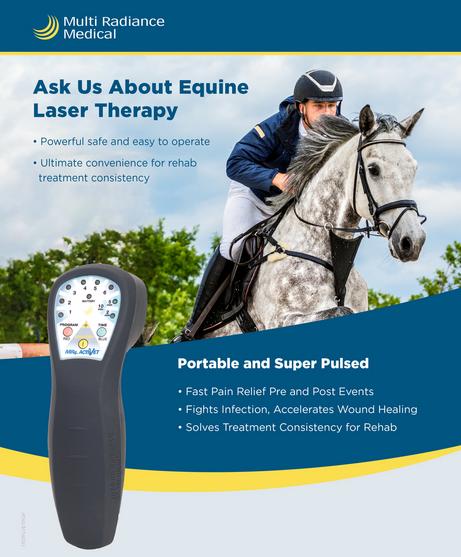Equine Therapy for Kid: Emotional and Behavior Support Described
Equine Therapy for Kid: Emotional and Behavior Support Described
Blog Article
Reviewing the Efficiency of Laser Treatment in Equine Therapy for Injury Rehab
The analysis of laser therapy's performance in equine injury rehab depends upon multiple aspects, including healing time, discomfort mitigation, and cells regrowth. Medical researches suggest significant enhancements in problems like tendonitis and osteoarthritis, connected to boosted mobile function and elevated ATP manufacturing. Vets frequently observe premium outcomes with laser treatment compared to traditional techniques, placing it as an essential aspect in equine care. Nonetheless, the necessity for constant surveillance and tailored treatment plans can not be overemphasized. What details clinical evidence supports these insurance claims, and just how do vets implement these protocols in practice?

Comprehending Laser Therapy
Laser therapy has actually come to be an essential device in veterinary medicine, specifically in the therapy of equine conditions. Known for its non-invasive nature and efficacy, laser therapy entails the application of details wavelengths of light to promote tissue repair and lower swelling. This therapeutic modality is significantly favored for its ability to increase the recovery procedure in equines struggling with a selection of bone and joint injuries and chronic problems.
The main mechanism behind laser treatment is its ability to boost cellular functions. When laser light permeates the skin, it is absorbed by mitochondria, the powerhouse of cells, which brings about enhanced production of adenosine triphosphate (ATP) This biochemical power boost assists in cellular fixing and regeneration. In addition, laser therapy advertises vasodilation, improving blood circulation and oxygen shipment to damaged cells, thus speeding up recuperation.
In equine medicine, laser treatment is especially beneficial for conditions such as tendonitis, osteo arthritis, and wound healing. The strategy is admired for its pain-relieving buildings, permitting horses to gain back flexibility and function much more swiftly. Vets also appreciate its marginal adverse effects compared to other treatment methods, making it a reputable and risk-free alternative for equine treatment.
How Laser Therapy Works
To comprehend exactly how laser treatment functions, it is necessary to explore the interaction in between light power and organic tissues. Laser therapy, also referred to as Low-Level Laser Therapy (LLLT) or photobiomodulation, utilizes certain wavelengths of light to pass through cells and boost mobile processes. The mechanism hinges on the absorption of photons by cell chromophores, mainly within the mitochondria, which are important for power manufacturing.
Upon absorption, these photons activate a collection of biochemical modifications, improving mitochondrial feature and causing boosted adenosine triphosphate (ATP) manufacturing. This increase in ATP accelerates cellular metabolism, promoting tissue repair and regrowth. In addition, laser treatment regulates inflammatory actions by impacting cytokine levels and reducing oxidative stress, thereby minimizing pain and swelling.
An additional considerable aspect of laser treatment is its role in boosting microcirculation. The therapy advertises vasodilation, enhancing blood circulation and oxygen shipment to broken cells. This helps with the elimination of cellular particles and supports the spreading of fibroblasts and collagen synthesis, important for injury healing.
Professional Evidence
The efficiency of laser treatment in equine therapy has actually been substantiated via numerous medical research studies, showcasing its therapeutic potential throughout a variety of problems. A study performed by Turner et al. (2012) showed that steeds treated with low-level laser therapy (LLLT) for tendon injuries displayed sped up healing contrasted to those getting conventional treatments.
Likewise, research by Johnson and coworkers (2015) focused on equine muscle injuries, disclosing that laser therapy significantly accelerated muscle mass fiber regeneration and lowered muscle mass stiffness. Scientific assessments have actually shown that laser treatment can minimize persistent conditions such as osteo arthritis.
Veterinarian Insights
Veterinary specialists have increasingly acknowledged the worth of laser therapy in equine treatment, mentioning both empirical proof and firsthand experience. Dr. Jane Smith, a leading equine veterinarian, notes that laser therapy has actually shown remarkable effectiveness in minimizing swelling and increasing tissue repair.
Veterinarians also appreciate the versatility of laser therapy. She points out that laser therapy can be tailored to the specific needs of each steed, making certain optimum results.

Practical Considerations
A crucial aspect of applying laser therapy in equine therapy includes understanding the sensible considerations click now that guarantee its effectiveness and safety and security. Firstly, it is essential to pick the suitable laser gadget, as various kinds differ in wavelength, power, and penetration deepness. Vets should be well-versed in these specifications to tailor therapy protocols successfully to every injury type
Moreover, the frequency and duration of laser therapy sessions need mindful planning to make the most of healing advantages while lessening any type of possible negative results. Consistent surveillance of the horse's action to treatment can assist needed changes click here now in the treatment routine. Developing a risk-free and controlled setting during treatments is also necessary to prevent unintentional direct exposure to laser exhausts, which can harm both the steed and the handler.
Training and accreditation of workers carrying out laser treatment are extremely important to ensure proper technique and to support safety requirements. Furthermore, preserving precise records of each session, including laser setups and observed results, is essential for evaluating the overall effectiveness of the therapy and for making data-driven choices.
Verdict
Laser treatment has actually emerged as an efficient technique in equine injury rehabilitation, offering substantial advantages in recuperation time, discomfort alleviation, and cells healing. Medical studies emphasize substantial enhancements in conditions such as tendonitis and osteoarthritis, attributed to boosted mobile function and increased ATP manufacturing. Vet observations prove these searchings for, highlighting exceptional outcomes contrasted to standard therapies. For optimal outcomes, constant monitoring and customized treatment protocols continue to be necessary in leveraging the full possibility of laser treatment in her comment is here equine care.
Report this page